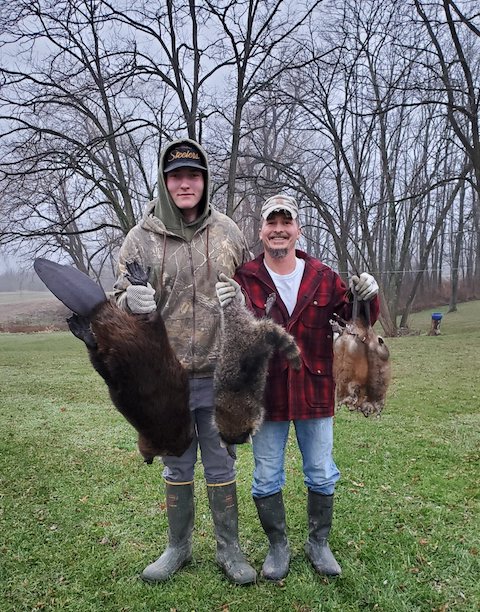 Team Fur News - Oct24
Team Fur News - Oct24
Priorities
By FUR-FISH-GAME Editor, John D. Taylor
.jpg)
Sometimes, you just have to set priorities. Photo: Jeffrey Hamilton/Unsplash
The store, Midway Super Thrift was built half in Red Lion the other half in Dallastown, both small southcentral Pennsylvania towns. While the actual boundary between the two communities was practically invisible – a traveler driving state Route 74 wouldn’t know they’d crossed from one to the next – there was definitely a cultural boundary between them. This was marked by intense sports team rivalry, especially football. Many small towns in Pennsylvania during the 1970s were like that.
I was 15 in the summer of 1976 when I got my first job at Midway Super Thrift. It was part-time, a couple evenings after school and on weekends. And I was likely hired because my maternal grandmother’s gentleman friend, Jimmy Jamison, a retired state worker, also worked there part time. Before you get hinky ideas about Grandma, know my grandfather passed away in a construction accident when I was barely 2 years old. So, she was certainly allowed to have a gentleman friend.
Officially, I became a grocery clerk. What that meant was that I fetched carts from shoppers returning them in the parking lot – most people did back then – and I helped little old ladies load their groceries into cars that reeked of Dove soap and were only driven to church on Sundays. I did that job rain or shine, heat or cold, and I wore a dress shirt, dress pants, good shoes and a tie with a white kitchen-type apron over top. Society was much more genteel back then, with expectations of decorum, even in menial jobs.
If you were good enough at cart wrangling, or the bosses – big, gruff, but fair Walt Sunderhoff or Rich Longnecker – felt sorry for you melting under summer heat or freezing in winter cold, you got to go inside and be a bagger for short stints.
There were no plastic tote sacks back then, only large, stout paper bags. And there was an art to packing them. The object was to pack the bag so it held as many groceries as possible, without it being too heavy or having it bust open when people moved bags from their cars into their homes.
Canned goods and heavy stuff, like flour or sugar bags, always went in first. Flat boxes, like cereal or Hamburger Helper, perched around the inside edges. Then you filled in with smaller boxed packages like cake or cornbread mixes. The whole thing was topped with bread, rolls or potato chips. You were also expected to bag the cold stuff – ice cream, frozen foods – separately. Milk came in the same plastic jugs, yet most people were still getting milk delivered in glass bottles to their homes by a milkman who drove a refrigerated delivery truck around.
One of the perks of being a bagger was being able to talk to customers – people actually did that back then – and hanging around the high school-age cashiers, many of them very attractive school girls. The clerks and cashiers came from both Dallastown, like me, and exotic, more rural Red Lion.
If you were a good enough bagger, and worked hard, you might occasionally get to go in the back of the store and stock shelves. Or what was even cooler, you might be chosen to build end displays with Rich Longnecker on Saturday mornings.
There was a precise art to that, too, and Rich was quite particular about it. Using a razor blade boxcutter – they allowed kids to have them back then – you sliced a 2-inch-tall tray around the bottom and top of, for example, a box of Del Monte pineapple cans. You removed the cans, marked their price with a blue ink stamper, then faced every can so the customer could see the label. The trays of cans were then stacked to create the end display. Properly built, end displays looked sharp and could withstand the bump of an errant shopping cart.
By spring of 1977, I was mostly stocking shelves and building ends. I enjoyed grocery store work, especially those two things... and bagging.
There was one cashier, Jackie, a Red Lion girl, who I especially enjoyed bagging for. Being around her was like holding a live electrical line. She was outgoing, full of energy, perky, smiling, always having a good time chatting with customers. If auras exist, hers would have glowed golden, like bright sunshine. And she seemed to enjoy having me around, bagging for her.
Naturally, I wondered about her relationship status. She had a boyfriend, a high school senior, from a prominent Red Lion family, the kind of guy who was definitely going someplace in life. He also worked at Midway. He struck me as a slick, smooth talker, likely headed for a political career, since his college goal was a political science degree at a big-time university. I actually liked the guy.
In the late summer of 1977, when he was headed to college, they broke up. And after a while, I somehow summoned the courage to ask Jackie out. That first date, we went to Beefsteak Charlies, a nice East York, Pennsylvania, restaurant, and a then to a movie. I was 17 and could drive my folk’s new Ford Granada. I felt like I’d hit the big time.
Following a couple other dates, Jackie started talking about Red Lion’s homecoming dance. I could take a hint, and suggested we go. But when she gave me the dance’s mid-October date, I remembered another very important date – Pennsylvania’s squirrel opener.
Squirrels were the first hunting season I participated in back then. My face crinkled with angst, and Jackie saw it.
Then the lightbulb went on over my head.
“Geeze, Jackie, I can go squirrel hunting in the morning, then take you to homecoming in the evening. What a day!” I blurted.
As those words left my lips, the mental image of a camo-clad hunter with bloody hands holding a squirrel carcass, escorting a beautiful teenager in a new homecoming dress into a dance flashed across my mind. She probably thought that, too.
Trying to recover a bit, I think I said something about her being the best part of that day.
Homecoming day, I hunted squirrels in the morning in the Boy Scout woods and took Jackie to the dance that evening. I made sure my hands were quite clean, and I wore a spiffy 1970s rented tuxedo, powder blue, the go-to color at the time. We had several more dates over time, but the spark that may have started an “us” fizzled for Jackie and she ended it before too long into Pennsylvania’s pheasant season, well before deer season.
I took that kinda hard, but eventually got past it.
I still mark my life by season openers – sharptail season; antelope, or this year South Dakota prairie cow elk season; pheasant season; deer season; coyote season; spring turkey season; then horse riding and fishing season, when my version of the calendar begins again.
Every October, I think of Jackie and my squirrel hunting comment, and I chuckle. I hope she’s happy. I sure am, especially during sharptail season.
Help IDNR track hemorrhagic disease
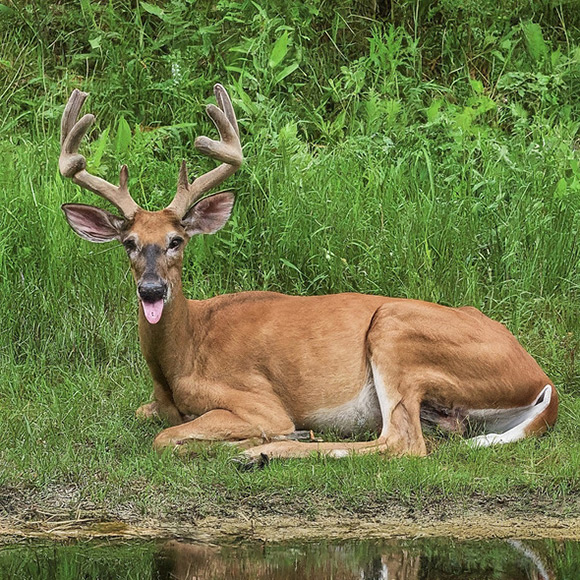
Deer suffering from hemorrhagic disease are often found near water where they try to drink away a burning sensation, a symptom of the disease. Photo: IDNR
Hemorrhagic disease, commonly referred to as EHD or bluetongue, has been killing Iowa deer for more than a decade, with severe outbreaks occurring in 2012, 2013, 2019 and 2023. To better understand the disease’s impacts, the Iowa Department of Natural Resources (IDNR) has created an online tool where hunters and landowners can report dead deer resulting from hemorrhagic disease outbreaks. The new reporting tool, plus an annual dashboard, is linked to the Deer Hunting and Deer Health Webpage (www.iowadnr.gov/deer). Hemorrhagic disease has previously been underreported. It’s hoped this new tool will simplify the process and improve the accuracy of the number of deer and the areas impacted. Submitting reports helps IDNR understand and manage Iowa’s deer populations. Characteristics of hemorrhagic disease include deer dying between July and September, occasionally later, during unseasonably warm weather, and finding more than one deer carcass, especially near a water source. Outbreaks vary in severity year to year. There is no effective treatment or known prevention for wild deer. Hemorrhagic disease is typically localized: Deer on one property may experience a severe outbreak, deer on a neighboring property do not. Generally, deer populations recover to near normal levels 2 to 3 years later.
Wisconsin Public Access Lands Web Map Available
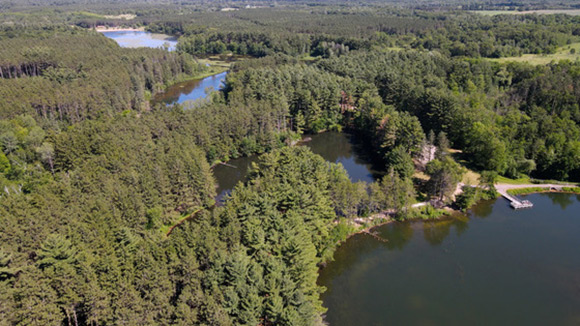
Wisconsin’s Public Access Lands web mapping app is user-friendly and
available for mobile devices. Photo: WDNR
From state natural areas to trails, lakeshores and rivers, Wisconsin has a wealth of public lands for everyone to enjoy. The Wisconsin Department of Natural Resources (WDNR) has a new web mapping application – the Public Access Lands app – for people to find public land in the state. The app is designed for desktop and mobile devices, with user-friendly tools. The Public Access Lands app makes it easy to find state lands for hunting, hiking or fishing, and includes Open Managed Forest Law/Forest Crop Law properties. The web-based mapping app provides up-to-date property information, including maps, restricted areas and links to webpages, if available. It also shows WDNR parking areas and boat access sites and complements the printed Public Access Lands Atlas, which contains 441 maps covering statewide public lands, roads and waterways. Visit https://dnr.wisconsin.gov/topic/fl/RealEstate/PAL.
Working Grasslands Partnership Program
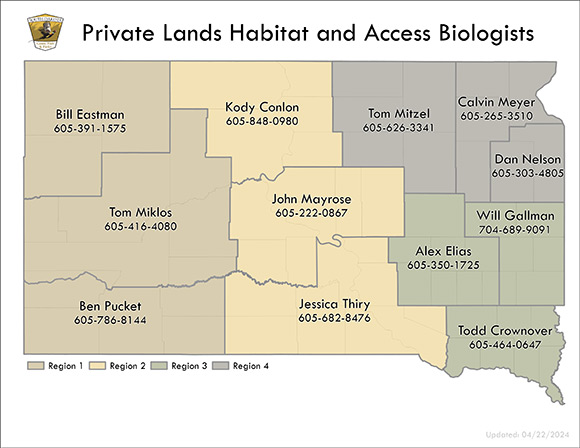
South Dakota Game, Fish and Parks, along with Ducks Unlimited, has a new program for landowners offering annual payments to restore cropped land back to grassland.
South Dakota Game, Fish and Parks (SDGFP), along with Ducks Unlimited, has a new program for farmers, ranchers and other landowners. The Working Grasslands Partnership will offer annual payments for landowners who restore cropland back to grassland. The payments will provide income on these acres for landowners who defer grazing and haying during the first two to three years. Once established, the perennial cover can be incorporated into the landowner’s grazing and haying operation. Annual payments are determined by using the average CRP rental rate for the county the land is located. SDGFP can also assist with seed costs by providing 100% cost share of up to $125 per acre. This new combination of payment for seed and annually deferred payments brings strong financial and technical support to help landowners with this transition from cropland back to grass. Visit https://habitat.sd.gov/
FUR-FISH-GAME 100th Anniversary Ornaments
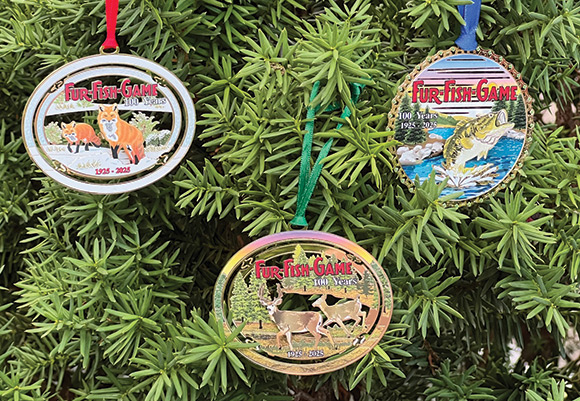
In case you didn't know it, FUR-FISH-GAME Magazine is about to begin its 100th year. While our September 2025 issue will be the center of our commemoration, we thought we'd kick it off early just in time for Christmas. There's no better way to celebrate the FUR-FISH-GAME 100th anniversary than with a collector's ornament custom made for your favorite magazine. Three distinct designs perfectly exemplify our name: a Fox, a Bass, and a Deer.
• 2-dimensional design
• Custom made exclusively for FUR-FISH-GAME
• Fox: 3-inches wide by 2-1/2 inches tall; red ribbon; green storage box
• Bass: 2-3/4-inches wide by 2-3/4 inches tall; blue ribbon; red storage box
• Fox: 3-inches wide by 2-1/2 inches tall; green ribbon; black storage box
• Etched and painted solid brass
• Made In the USA by the company that makes ornaments for the White House Historical Association
• Only $19.95 each, or a full set for $54.95.
Purchase them here: https://www.furfishgame.com/store/new_products.html - or call the office at 614-231-9585 M-F, 9am-4:30pm EST. As you might imagine, these are likely to sell out, so hurry.
Montana and Bears
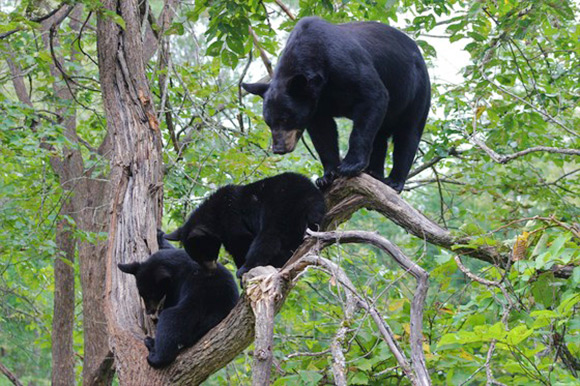
Hunters or anglers heading to Montana would do well to become Bear Aware. Photo: WVDNR
Hunters or anglers heading to Montana would do well to become Bear Aware, says Montana Fish, Wildlife and Parks (MFWP). In late August, for example, an angler was injured in a black bear attack on the Stillwater River, near Beehive. The angler, an adult man, was fishing alone on the river’s bank when he encountered a black bear. The bear swatted the man’s face, then left the site. The man sustained non-life-threatening injuries and didn’t seek medical attention. The bear’s behavior was likely defensive, in a surprise, close encounter, so no further actions were taken. Still, even in central and eastern Montana, hunters and anglers are encouraged to be bear aware. Although bear encounters are rare there, black bears are present in the Little Rockies and Bear Paw Mountains, and grizzlies have been confirmed recently near Big Sandy, the Bear Paw Mountains south of Havre, and in the Missouri Breaks. Becoming bear aware includes:
• Carrying bear spray in an accessible place and knowing how to use it.
• Staying alert for bear activity, especially where visibility or hearing is limited in woods, bushy areas and along streams. Make noise whenever possible to avoid surprising a bear.
• Traveling in groups to keep members, especially kids, together. Also, avoiding traveling at night, dawn or dusk. Also, avoid carcass sites and scavenger concentrations.
• Hunters should use special precautions: Pack meat out as soon as possible, or properly hang meat until you can retrieve it. If you must leave a downed animal, leave it in an area easy to observe from a distance, then return to the site carefully. Drag gut piles into open areas, if possible, and at least 100 yards from a carcass as soon as possible.
For more on bear safety, visit fwp.mt.gov/bear-aware.
West Virginia Record Crappies
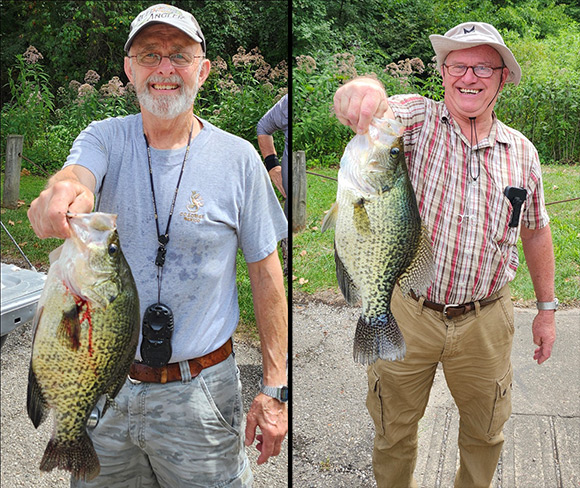
Two West Virginia anglers – Lindell Marker, of Sod, and Dwight Priestley, of Alum Creek – fishing from the same boat on same day, caught state-record black crappies at Woodrum Lake. Photos: WVDNR
At 7:30 a.m., Lindell Marker, of Sod, caught a 17.36-inch black crappie, surpassing the previous length record of 17.32 inches set by Craig Webb, also caught at Woodrum Lake. Marker’s catch tied the existing weight record of 2.85 pounds, also held by Webb. An hour and 15 minutes later, Dwight Priestley, of Alum Creek, fishing from the same boat, caught a 17.76-inch, 3.15-pound black crappie that surpassed Marker’s record and set new records for length and weight. Both fish were certified by WVDNR Fisheries Biologist Cory Hartman. Live minnows caught the record-breakers. WVDNR has reported eight record-breaking catches in 2024, including a channel catfish, another black crappie, a redear sunfish, a redbreast sunfish and a tiger trout. For more about state fish records, visit WVdnr.gov/state-records.
Idaho Deer, Elk Hunting Looks Promising
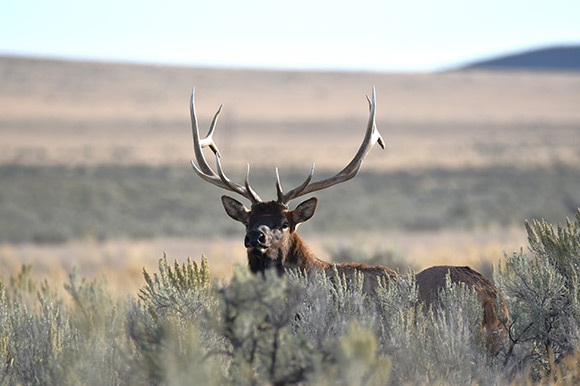
Hunters headed to Idaho this fall could see better hunting than in 2023
says Idaho Fish and Game. Photo: IFG
Hunters headed to Idaho this fall could be in for better hunting than in 2023. Deer and elk numbers look promising, says Idaho Fish and Game (IFG). Elk numbers are generally healthy and stable. IFG Deer and Elk Coordinator Toby Boudreau noted that 87% of collared elk calves and 96% of collared cows made it through the winter, a few percentages higher than most years. Statewide, mule deer numbers appear to be improving. Winter survival is typically the driving factor for mule deer. Typically, about 60% of fawns survive their first winter. However, collared mule deer in one area’s study population, 77% of fawns and 95% of does made it through to spring. Even eastern Idaho’s muley numbers — after suffering from one of the worst winters on record in 2022 – 2023 — are gradually starting to grow. And while scorching summer weather can spark epizootic hemorrhagic disease (EHD) outbreaks in whitetailed deer, so far, there’s no sign of any significant outbreaks. Whitetails saw the only hunter harvest increase in 2023, and their number appear good.
Harmful Algae Blooms
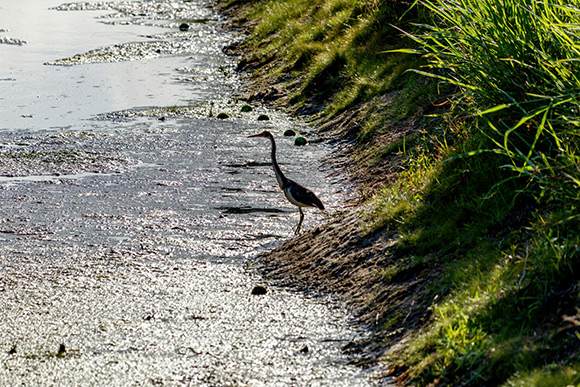
Algal blooms can contain deadly algal toxins like cyanobacteria and microcystin.
People and pets should stay away. Photo: microfile.org/Unsplash
Harmful algal blooms (HABs), typically occur during periods of warm temperatures, lots of sun and high nutrient levels. HABs can present a health hazard – even cause death – to people and especially pets. Michigan's Department of Environment, Great Lakes and Energy (EGLE) staff discover or receive reports from lake associations and the public about HAB conditions. The number of these reports, particularly where cyanobacteria or blue-green algae blooms occur, and the presence of algal toxins such as microcystin, have increased recently. Since it’s impossible to determine whether algal blooms contain harmful toxins by looking at them, EGLE recommends avoiding contact with any water covered with algal mats or significant rafts of algae on the surface. EGLE and the Michigan Department of Health and Human Services (MDHHS) sample for HABs on a limited basis and work with local health departments to protect the public when toxins are discovered. Suspicious-looking algae can be reported to EGLE by calling the Environmental Assistance Center at 1-800-662-9278 or sending an e-mail to AlgaeBloom@Michigan.gov.
Minnesota Pheasant Numbers Like 2023’s
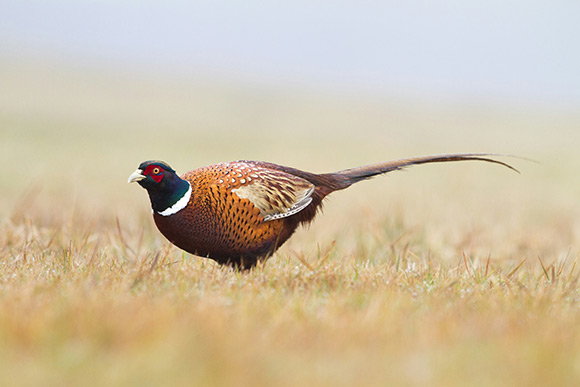
Minnesota pheasant hunters can expect to see bird numbers
similar to last fall. Photo: Jack Seeds/Unsplash
A wet spring and summer impacted the nesting and brood-rearing season for Minnesota’s pheasants, according to the 2024 August Roadside Survey. Survey counts were similar to 2023, yet 19% above the 10-year average, says Minnesota’s Department of Natural Resources (MDNR). MDNR says stability in statewide pheasant numbers was welcome news after the wet spring and summer. Although a milder winter meant more hens were available for nesting, this likely offset chick losses due to wet breeding season conditions. The number of broods per 100 hens declined by 21% compared to the 10-year average, and the number of chicks decreased by 12%. The overall pheasant index was 52 birds per 100 miles of roads driven, compared to 51 birds per 100 miles of road driven in 2023. Pheasant numbers increased the most in the east central region (70%), followed by the central (34%), southcentral (8%), and westcentral (6%) regions. Despite a decline in the southwest region (29%), it still had the greatest number of birds, 82 birds per 100 miles, and should provide some of the best hunting opportunities. Still, overall pheasant index numbers were below the long-term average.
Gray (Hungarian) partridge numbers decreased statewide in the roadside survey. Yet partridge numbers increased by 50% in the southwest region, from 7.6 birds per 100 miles in 2023, to 11.4 birds per 100 miles in 2024. All other regions had less than 1.3 birds per 100 miles.
The Conservation Reserve Program (CRP) plays a large role in providing high-quality upland bird habitat in Minnesota. This federal Farm Bill program pays farmers to remove land from agricultural production and restore vegetation to reduce soil erosion, improve water quality and provide wildlife and pollinator habitat. Overall, CRP acres showed a net increase of 9,800 acres in 2024. But not all those added acres were grassland, what’s best for pheasants. Long-term CRP trends show a decline. Minnesota’s pheasant season opens at 9 a.m. Saturday, October 12 and closes on January 1, 2025. Hungarian partridge season is currently open and closes January 1, 2025. Visit mndnr.gov/hunting/pheasant
Enroll In Hunter Education

Wisconsin has a Hunter Education course available to suit anyone’s needs. Photo: WDNR
The Wisconsin Department of Natural Resources (WDNR) encourages the public to prepare for hunting season by taking a Hunter Education course. Whether you’re looking to learn more about firearm safety or want to give hunting a try, WDNR has classes to help you get started. Hunter Education plays a vital role in keeping Wisconsin a safe place to hunt. Anyone born on or after January 1, 1973, is required to hold a certificate in Hunter Education to purchase a hunting license. WDNR offers multiple course options and locations, so hunters can choose the best format for how and where they’d like to learn:
• Traditional Course - Students attend a multi-day, in-person course to learn hunter responsibility and safety through lectures, demonstrations, group discussions, practical exercises and individual study. The students then take a multiple-choice exam and complete a hands-on, skills-based assessment based on information found in the printed student manual and taught during class.
• Internet and Field Day - Students must enroll in an in-person field day course and then complete the online portion before attending the field day. After completing the online course, students will receive a field day voucher, which is required to participate in the in-person field day course they enrolled in. Students will reinforce what they learned online through hands-on safe firearm handling, demonstrations from experienced hunters and practical exercises. The students then take a multiple-choice exam and complete a hands-on, skills-based assessment.
• Online-Only - The online-only course has the same general content as the other course options but is entirely online and available for those 18 and older. Students work through online units, take multiple-choice quizzes and take a final multiple-choice exam. This course is specifically for students with prior hunting or firearms handling experience.
Visit https://dnr.wisconsin.gov/Education/OutdoorSkills/safetyEducation.
Moss Balls May Contain Invasive Zebra Mussels
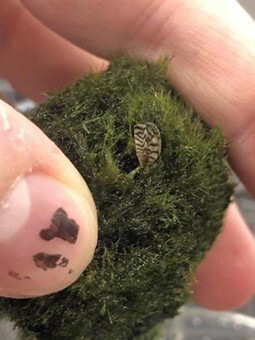
The Missouri Department of Conservation encourages retailers and aquarium owners to
check their moss balls for a potential zebra mussel infestation. Photo: MDC
The Missouri Department of Conservation (MDC) is encouraging anyone who purchased Marimo moss balls within the last year to inspect them and decontaminate their aquariums, due to a potential zebra mussel infestation. Moss balls containing the invasive species have been discovered in Washington state and it’s possible they were distributed to buyers in Missouri. Zebra mussels are an invasive species first reported in Missouri in 1991 in the Mississippi River near St. Louis. They’ve since spread to the Missouri, Osage and Meramec rivers, also streams downstream of infested lakes. Zebra mussels can clog power plants, industrial and public drinking water intakes, foul boat hulls and motors, decimate native freshwater mussels, impact fisheries and disrupt aquatic ecosystems. Any aquarium containing moss balls infected with zebra mussels has the potential to have zebra mussel larvae (called veligers) in its water. When aquarium water is poured down drains or if the contents are dumped into a nearby creek or lake, this could introduce zebra mussels into a new body of water. MDC urges retailers and aquarium owners who bought moss balls in the last year to check them for zebra mussels and decontaminate or dispose of if found. Report zebra mussels in moss balls to MDC regional offices. To learn how to properly decontaminate zebra mussel-infected moss balls and aquariums systems visit https://www.fws.gov/media/zebra-mussel-disposal-instructions. For more information on zebra mussel control visit https://mdc.mo.gov/wildlife/invasive-animals/zebra-mussel-control.
Endangered California Condor Shot in Colorado
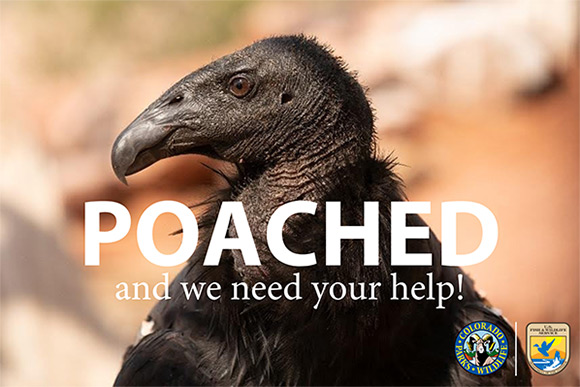
Colorado Parks and Wildlife and the U.S. Fish and Wildlife Service are asking the
public for help with information regarding the shooting of an endangered California
condor earlier this year. Photo: The Peregrine Fund
A critically endangered California condor was shot and killed late in March this year in Montezuma County, Colorado. As a result, Colorado Parks and Wildlife (CPW) and the U.S. Fish and Wildlife Service (FWS) are asking the public for help with any information regarding the shooting. The California condor was discovered shortly after it was killed, in a remote area northeast of Lewis, Colorado, and west of McPhee Reservoir in Montezuma County Currently, leads have not yielded results, so CPW and the FWS are asking the public for information about the incident and those responsible. California condors are an endangered species, protected under the Endangered Species Act. It’s illegal for anyone to harass, harm, pursue, hunt, shoot, wound, kill, trap, capture or collect California condors. The individuals involved in killing these birds could face a third-degree felony charge of wanton destruction of protected wildlife, with a maximum fine of $5,000, restitution of $1,500 and a five-year prison sentence.
The historical California condor population declined to just 22 individuals in the wild by 1987. FWS’s California Condor Recovery Program, a captive breeding and release effort has produced results. As of June 2024, there are 85 condors in the wild in the rugged canyon country of northern Arizona and southern Utah. This number declined in 2023 due to avian influenza. The current population of California condors is more than 560 birds, with more than half in Arizona, Utah, California and Mexico. Anyone with information regarding this incident is urged to come forward and assist with the investigation. Tips can be submitted to CPW’s Operation Game Thief hotline, 1 (877) 265-6648 or via email, game.thief@state.co.us; also, via FWS’s tip line (844) 397-8477 or www.fws.gov/wildlife-crime-tips. A reward may be available if information leads to a successful prosecution of the responsible parties. CPW and FWS assure confidentiality for those who come forward.
Events
Indiana State Trappers’ Association Fur Sales
Two 2025 Indiana State Trappers’ Association (ISTA) Fur Sales will take place in 2025: The first takes place on January 25, 2025, at the Old Friendship Church, in Linville, Indiana. The second will take place on February 8, in Peru, Indiana, at the Miami County Fairgrounds. You must be an ISTA member to sell. Lot numbers can be purchased prior to the sale date. Doors open at 8 a.m. Sales begin promptly at 9 a.m. local time. Note: Linville is in the Central Time Zone and Peru is in the Eastern Time Zone. Fur buyers from several states will be in attendance. The events include food, trap raffles, 50/50 contests and other activities. Come for the fun and enjoy the largest fur sales in Indiana. For more information call or text Byron Tiede at (219) 863-3803.
New Mexico Trappers’ Association Fur Sales and Rendezvous
The New Mexico Trappers’ Association (NMTA) will hold three events in 2025: A Trappers’ Fur Sale will take place on February 28 and March 1, 2025, at the Torrance County Fairgrounds in Estancia, New Mexico Contact. NMTA will also hold their rendezvous June 13 and 14, 2025, at the Mountain View Christian Camp, in Alto, New Mexico. Contact Shelly (575) 649-1684 or gypsytrapper@yahoo.com.
Coming in November
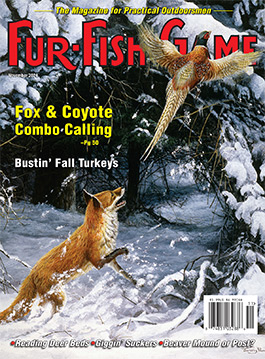
Features
• Stick on a String - Richard P. Smith shares how Phil Henry, a Tennessee hunter, uses a stick on a string to lure in big bucks.
• Bull Gadwalls - Jeffery Miller says gadwalls get little respect from most waterfowlers, but for Miller, they’re a special duck, fun to hunt, great on the table.
• When In Doubt for Fall Turkeys, Bust’Em! - Bruce Ingram shares his tried-and-true tactics for putting a Thanksgiving turkey on the table.
• Whitetail Deer Bedding Breakdown - Alex Merritt tells how to understand deer beds and capitalize on bedding behavior to tag a big buck.
• Sucker Gigging in the Ozarks - Jacob McIntosh shares a fascinating look at sucker gigging in the Ozarks past, present and how to do it.
Other Stories
Island Canines – John Murray shares his techniques for trapping coyotes and foxes around brushy field islands.
Scent Mound or Scent Post – Kevin Waterman looks at these two variations on beaver behavior and how to trap them.
The Best Way to Hunt Coons – John Stock shares his techniques for calling and hunting coons.
Wolves of the Birchwood, Chapter 3 – The Lew and Charlie saga continues.
How to Hit More Grouse – Alan Davy looks at ways to connect with more ruffed grouse.
Multiple Species Drift Fishing – Rob Dankowsky shares his tactics for catching whopper muskies, smallmouths and fall run salmon via drift fishing large baits.
The Wasp – Dwayne Daugherty tells the story of a recurve bow and how hit brought him a “rock,” a Pope and Young buck, on an Army base.
Old Style Rabbit Hunting – Robert Sellers reminisces about rabbit hunting in southcentral Pennsylvania during the 1960s.
Hunting With My Granddaughters – Carl Erquiaga shares his experiences hunting mule deer with his granddaughters and what they learned together.
Average – Chuck Alexander shares a touching tale about duck hunting in his Maine small town and the development of a special friendship between his son and Phillip, a retired game warden and fellow waterfowler.
End of the Line Photo of the Month
Caleb Anslow & Kelly Rozzi, Fowler, Ohio
SUBSCRIBE TO FUR-FISH-GAME Magazine

